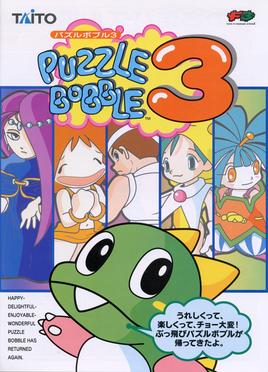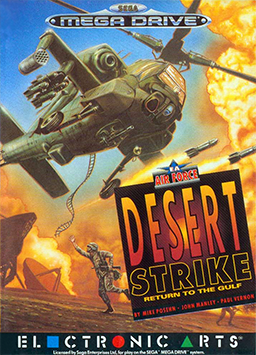
Puzzle Bobble, internationally known as Bust-A-Move, is a 1994 tile-matching puzzle arcade game developed and published by Taito. It is based on the 1986 arcade game Bubble Bobble, featuring characters and themes from that game. Its characteristically cute Japanese animation and music, along with its play mechanics and level designs, made it successful as an arcade title and spawned several sequels and ports to home gaming systems.

Virtua Cop is a 1994 light gun shooter game developed by Sega AM2 and designed by Yu Suzuki. It was originally an arcade game on the Sega Model 2 system, and was ported to the Sega Saturn in 1995 and Windows in 1996. The Saturn version included support for both the Virtua Gun and Saturn mouse, as well as a new "Training Mode" which consists of a randomly generated shooting gallery.

Darius Gaiden is a 1994 horizontal-scrolling shooter arcade game developed and published by Taito. The fifth entry in its Darius series, players control a starship named the Silver Hawk in its mission to destroy the Belsar empire before it wipes out the population of planet Darius. Gaiden adds several new features to the core concepts of its predecessors, including screen-clearing black hole bombs and the ability to capture mid-level bosses. The game has been ported to several consoles, including the Sega Saturn and PlayStation.

Einhänder is a scrolling shooter developed by Square for the PlayStation console. It was released in Japan on November 20, 1997 and in North America on May 5, 1998. It was also re-released for the Japanese PlayStation Network on June 25, 2008. The name Einhänder is German and denotes a type of sword that is wielded with one hand, here used to refer to the single manipulator arm possessed by the player's spacecraft.

Puzzle Bobble 3 is an action puzzle video game developed by Taito. The second sequel to Puzzle Bobble, it was released for arcades in September 1996 and later ported to the Sega Saturn, PlayStation, Game Boy, Nintendo 64 and Microsoft Windows. Like its predecessors, the player is tasked with shooting balls at groups of balls, creating groups of three or more, which are then removed from play. Further ports for the Nintendo Switch, PlayStation 4 and Xbox One were released in February 2023 by City Connection alongside Puzzle Bobble 2.

RayForce is a vertically scrolling shooter by Taito for the Taito F3 arcade hardware and released in 1994. It was ported to the Sega Saturn in 1995, Microsoft Windows in 1997, then rereleased for iOS in 2012 and Android in 2017.
A beat 'em up is a video game genre featuring hand-to-hand combat against a large number of opponents. Traditional beat 'em ups take place in scrolling, two-dimensional (2D) levels, while a number of modern games feature more open three-dimensional (3D) environments with yet larger numbers of enemies. The gameplay tends to follow arcade genre conventions, such as being simple to learn but difficult to master, and the combat system tends to be more highly developed than other side-scrolling action games. Two-player cooperative gameplay and multiple player characters are also hallmarks of the genre. Most of these games take place in urban settings and feature crime-fighting and revenge-based plots, though some games may employ historical, science fiction or fantasy themes.

G-Darius is a horizontally scrolling shooter arcade video game released by Taito in 1997. It is the fourth arcade installment of the Darius series and the first with three-dimensional polygonal graphics. A port to the PlayStation was published as G Darius.

RayStorm is a 1996 vertically scrolling shooter arcade video game developed and published by Taito. It has been ported to several consoles, including the PlayStation, Sega Saturn, and Xbox 360. Players control a starship, the R-Gray, in its mission to destroy the Secilia Federation before it destroys Earth.

Alpha Mission II is a vertically scrolling full screen shoot 'em up released by SNK in 1991 for the Neo Geo arcade and home systems. It is the sequel to the 1985 arcade game Alpha Mission. It was later released for the Neo Geo CD in 1994 and for the PlayStation Portable in 2010.

Philosoma is a shooter video game developed by G-Artists and published by Sony Computer Entertainment for the PlayStation. It was released in Japan in July 1995, North America in January 1996 and PAL territories in March 1996. It was re-released on the PlayStation Network in Japan on April 26, 2007. One of the earliest PlayStation games, it was met with mediocre reviews, with most critics assessing its graphics as dull and its gameplay as primitive.

Desert Strike: Return to the Gulf is a shoot 'em up video game released by Electronic Arts (EA) in March 1992 for the Sega Genesis. The game was released on several other formats such as the Super Nintendo Entertainment System, including a much upgraded version for the Amiga home computer. The game was inspired by the Gulf War and depicts a conflict between an insane Middle Eastern dictator, General Kilbaba, and the United States. The player controls an Apache helicopter and attempts to destroy enemy weapons and installations, rescue hostages and capture enemy personnel, while managing supplies of fuel and ammunition.

True Lies is a top-view run and gun video game based on the 1994 film True Lies. The game was developed by Beam Software and published by Acclaim Entertainment. Four different versions of the game were released for the Super Nintendo Entertainment System, Sega Genesis, Game Gear, and Game Boy. The home versions and portable versions are drastically different from each other, but have similar play mechanics.

Alien Trilogy is a first-person shooter video game developed by Probe Entertainment and published by Acclaim Entertainment in 1996 for the PlayStation, Sega Saturn, and MS-DOS platforms. The game is based on the first three movies in the Alien film series. One of the first games developed by Probe following their acquisition by Acclaim, it debuted Acclaim's much-hyped motion capture technology. The game was well-received by critics, who praised its recreation of the films' atmosphere and its gameplay depth compared to other first-person shooters, and was a commercial success.

Metal Black is a 1991 scrolling shooter arcade video game originally developed and published by Taito. Set in the dystopian future of 2052, players assume the role of rogue pilot John Ford taking command of the CF-345 Black Fly space fighter craft to defeat the Nemesis alien race and save humanity.

Burai Fighter is a shoot 'em up video game developed by KID for the Nintendo Entertainment System. The game was released in North America by Taxan in March 1990, PAL regions by Nintendo in 1990, and Japan by Taito on July 20, 1990. The game was ported to the Game Boy and retitled as Burai Fighter Deluxe, and was released in Japan on June 27, 1990, in North America in January 1991 and in Europe in 1991; this port was released for the Game Boy Color as Space Marauder, originally released in Japan as Burai Fighter Color, as the original Game Boy version is not compatible with the later models.

Total Eclipse is a space flight simulation video game developed and published by Crystal Dynamics for 3DO. It was later ported to the PlayStation under the title Total Eclipse Turbo. The game was copyrighted in 1993 and released 1994. Total Eclipse Turbo was a launch title for the PlayStation in the U.S., with the game's released date predating the North American console launch by 11 days. A sequel, Solar Eclipse, was released for Sega Saturn and PlayStation.

Space Gun is a 1990 first-person shooter arcade game released by Taito. The game is set aboard a crippled space station that has been overrun by hostile alien creatures. The objective is to rescue human crew members while destroying the alien creatures. The game lets the player shoot limbs off the creatures, resulting in blood splatters.

The Ninja Warriors is a beat 'em up video game developed by Natsume for the Super Nintendo Entertainment System and published by Taito in Japan and North America in 1994 and by Titus in Europe in 1995. It is a follow-up to Taito's 1987 arcade game of the same title, and shares similar gameplay. The player can choose between playing as one of three ninja androids, each with different attributes and a unique set of moves including jumps, dashes, throws, and other attacks. The game was developed by the same team at Natsume that later developed Wild Guns (1994).

Soviet Strike is a helicopter-based shooter game developed and published by Electronic Arts for the PlayStation in 1996 and the Sega Saturn in 1997. The game is a sequel to the Strike games which began on the Sega Genesis with Desert Strike: Return to the Gulf. Soviet Strike is the series' first installment for a 32-bit console and was first conceived as 32-bit Strike. Early on, it was intended for the 3DO platform, before development changed to the PlayStation.


















